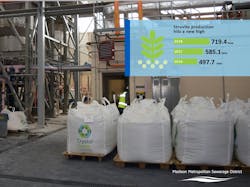Madison Metropolitan Sewerage District captures record volume of phosphorus, increases volume of clean water in 2018
MADISON, WI FEB 4, 2019 -- Madison Metropolitan Sewerage District continued to make progress in its work to enrich lives through clean water and resource recovery in 2018 as it captured a record volume of phosphorus from the wastewater stream and returned an increased volume of clean water to area streams.
The district shipped the phosphorus out of the watershed as tiny pellets of struvite fertilizer under the brand name Crystal Green. Michael Mucha, the district's chief engineer and director, said the district continues to optimize the Ostara process and also piloted two additional phosphorus management technologies to reduce impacts to surface water during 2018.
"We currently remove about 96 percent of the phosphorus entering the plant and we're studying whether next-generation technology can effectively repurpose or remove additional increments of this valuable mineral," Mucha said. "We're currently evaluating the costs and benefits of additional, very different approaches to phosphorus management."
During 2018, the district produced 719.4 tons of struvite fertilizer, up from 585.1 tons in in 2017. The struvite total is equivalent to more than 180,000 pounds of pure phosphorus and as a controlling nutrient, a single pound of phosphorus can lead to 500 pounds of algae.
Due to heavy precipitation in the latter half of the year as well as growth in its 26 customer communities, the district also cleaned and reclaimed 16.86 billion gallons of clean water, up from 16.03 billion gallons in 2017. The district operates sanitary-only sewer lines and works with its customer communities to reduce groundwater infiltration and stormwater inflows into the system. However, during heavy rains and flooding, stormwater enters the sanitary system through manholes, flooded basement floor drains and other sources. The district treats incoming wastewater from all sources to produce effluent that is approved for return to the environment.
The treated effluent is a valuable resource, accounting for more than 90 percent of the flow at the discharge points that feed Badfish Creek State Wildlife Area and Badger Mill Creek, a class 2 trout stream. During 2018, the district returned approximately 15.73 billion gallons of water to Badfish Creek and 1.18 billion gallons to Badger Mill Creek while reusing 185.2 million gallons for purposes within the plant. (The numbers do not add perfectly due to factors including rounding and the use of city water.)
During 2018, biogas production dipped as the district churned out 289 million cubic feet, down from 305.1 million cubic feet in 2017. The district used this biogas supply to generate some 5.9 million kilowatt-hours of electric power to offset its own energy use. The drop in biogas production reflects more inert material such as grit entering the system during high flows as well as system maintenance during the year.
Other resources reclaimed by the district in 2018 included processing of 1.9 million gallons of liquid biosolids into class A cake biosolids, which hold potential in diverse markets including residential application. The district also produced 35.3 million gallons of class B Metrogro liquid biosolids for use as a sustainable, local fertilizer by farmers in the region. District staff members continue to innovate with evaluation and testing of a variety of these products to maximize value and distribution efficiency.
ABOUT THE DISTRICT
Established in 1930 to protect the lakes and streams of the upper Yahara watershed, Madison Metropolitan Sewerage District today serves 26 Madison area customer communities covering some 184 square miles and 380,000 people. The district owns and operates 141 miles of pipe and 18 regional pumping stations that convey approximately 41 million gallons of wastewater to the Nine Springs Wastewater Treatment Plant each day. Organized as a municipal corporation, the district is a leader in sustainability and resource reclamation; its rates are established by the Madison Metropolitan Sewerage District Commission.

